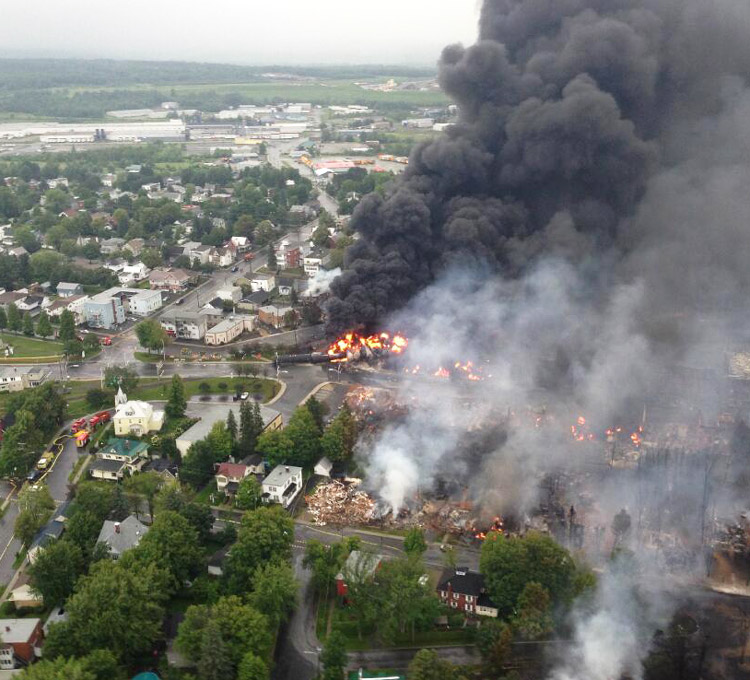LAC-MÉGANTIC, Quebec — “This is proof once more, that we are not safe in Lac-Mégantic,” Robert Bellefleur, spokeperson for Lac-Mégantic Citizens Coalition and Organizations for Rail Safety, told CBC News after two train derailments took place here Aug. 24. They occurred on a level crossing on the same route used by the runaway 72-car oil train that crashed and blew up, killing 47 people and destroying the town center in July 2013.
Bellefleur and others here have been fighting for the tracks to be relocated ever since that disaster.
Six years later the conditions for rail workers and the town’s residents remain as dangerous as ever. In both August derailments, train cars were dragged some distances with wheels off the tracks. One train was transporting dangerous chemicals.
The incidents occurred on defective rails on the steep hill above the town that a Transport Canada report in May said carried a “heightened risk of derailment.” The report noted that the number of defective rails in that area alone had risen from 115 in 2015 to 253 last year.
Central Maine and Quebec Railway claimed it fixed the tracks Sept. 5 and Transport Canada says it is now inspecting the repairs. The government ordered a 10-mile-per-hour speed limit on stretches of the track until the inspection is completed.
The citizens coalition is seeking an injunction to stop the movement of all dangerous goods in the region until all the rails have been repaired. The group “no longer trusts rail companies like CMQR,” Bellefleur said.
“The capitalists’ drive for profits lies behind the disaster and its aftermath in Lac-Mégantic,” Steve Penner, Communist League candidate for the federal riding of Papineau in Montreal, told the Militant in response to the recent developments. “This and the Aug. 15 death of a rail worker at the Canadian National yards in Toronto shows that it will take working-class struggle to win workers control of production and transportation,” he said.
Ongoing fight for a bypass
Despite a pledge by federal officials to build a railway bypass around the town, a route is still to be approved and chemical-laden cars using the unsafe tracks roll through Lac-Mégantic, generating profits for Central Maine and Quebec Railway shareholders.
“The authorities listen to Mr. Brassard, not the population,” retired masonite factory worker Giles Fluet told the Militant, referring to Louis Brassard, president of Tafisa, North America’s largest particle board plant. The factory is located in Lac-Mégantic’s industrial park. The company depends on the rail tracks, which were rebuilt through the center of town within weeks of the disaster.
After the 2013 disaster “the municipal council in league with developers decided to bulldoze dozens of buildings downtown,” even though they were not contaminated by the crude oil from the train wreck, Citizens Coalition activist and retired highway worker Gilbert Carrette said.
The original town center remains a vacant field to this day. Many working people these worker-correspondents spoke with complained about the unaffordable rents for apartments in the handful of new downtown buildings that have sprung up.
The government and rail bosses tried to frame up rail worker engineer Tom Harding and train dispatcher Richard Labrie, both members of United Steelworkers Local 1976, for the Lac-Mégantic disaster. A 12-member jury found them not guilty in 2018. In a statement for the citizens coalition after the verdict, Bellefleur told the press that those responsible for the deaths and destruction were bosses “at high management levels to ensure maximum benefits for top company officials and shareholders of the oil and railway companies involved.”
In fact, no charges were ever brought against Montreal, Maine and Atlantic Railway bosses.
“The government was quick to prosecute workers,” Pierre Arseneau, regional coordinator of the United Steelworkers, said after the verdict. “But it’s an entirely different story when it comes to corporate leaders.”


